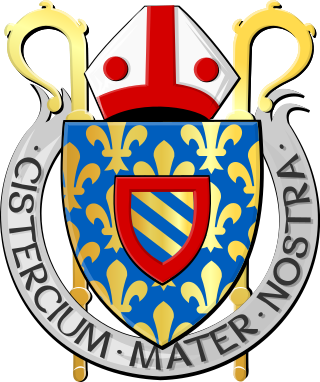
The Cistercians, officially the Order of Cistercians, are a Catholic religious order of monks and nuns that branched off from the Benedictines and follow the Rule of Saint Benedict, as well as the contributions of the highly influential Bernard of Clairvaux, known as the Latin Rule. They are also known as Bernardines, after Saint Bernard, or as White Monks, in reference to the colour of their cowl, as opposed to the black cowl worn by Benedictines.

Heiligenkreuz Abbey is a Cistercian monastery in the village of Heiligenkreuz in the southern part of the Vienna woods, c. 13 km north-west of Baden in Lower Austria. It is the oldest continuously occupied Cistercian monastery in the world.
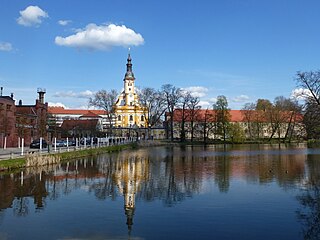
Neuzelle is a municipality in the Oder-Spree district of Brandenburg, Germany, the administrative seat of Amt Neuzelle. It is best known for Cistercian Neuzelle Abbey and its Neuzeller Kloster Brewery.

Zwettl Abbey is a Cistercian monastery located in Zwettl in Lower Austria, in the Diocese of St. Pölten.

Cistercian architecture is a style of architecture associated with the churches, monasteries and abbeys of the Roman Catholic Cistercian Order. It was heavily influenced by Bernard of Clairvaux, who believed that churches should avoid superfluous ornamentation so as not to distract from prayer. Although a few images of religious subjects were allowed, such as the crucifix, elaborate figures common in medieval churches were prohibited. Later abbeys were constructed in Renaissance and Baroque styles, which were more ornate by nature.

Wilhering Abbey is a Cistercian monastery in Wilhering in Upper Austria, about 8 km (5 mi) from Linz. It was founded in 1146. The buildings, re-constructed in the 18th century, are known for their spectacular Rococo decoration.
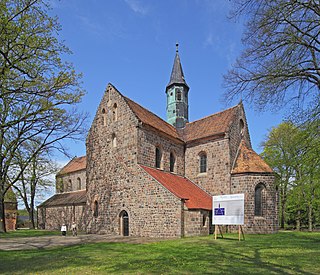
Zinna Abbey is a former Cistercian monastery, the site of which is now occupied by a village also called Kloster Zinna, today part of Jüterbog in Brandenburg, Germany, about 60 km (37 mi) south of Berlin. The village was established by Frederick II of Prussia as a village for weavers.
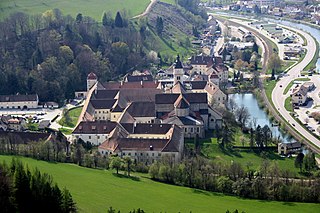
Lilienfeld Abbey is a Cistercian monastery in Lilienfeld in Lower Austria, south of Sankt Pölten.

Neuberg Abbey is a former Cistercian monastery in Neuberg an der Mürz in Styria, Austria, and is one of the few extant set of monastic buildings in Austria to have retained its medieval character to any great extent.

Millstatt Abbey is a former monastery in Millstatt, Austria. Established by Benedictine monks about 1070, it ranks among the most important Romanesque buildings in the state of Carinthia. The Benedictines were succeeded by the knightly Order of Saint George in 1469 and the Society of Jesus in 1598.

Rein Abbey is a Cistercian monastery in Rein near Gratwein, Styria, in Austria. Also known as the "Cradle of Styria", it is the oldest surviving Cistercian community in the world.
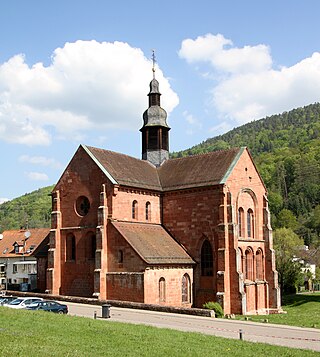
Eusserthal Abbey was a Cistercian abbey in Eusserthal near Annweiler am Trifels in the Rhineland-Palatinate, Germany. All that now remains of it is the front portion of the abbey church, which is now used as a parish church.
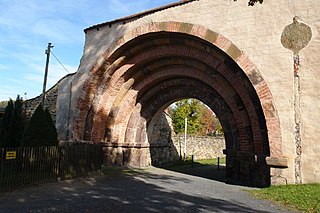
Altzella Abbey, also Altzelle Abbey, is a former Cistercian monastery near Nossen in Saxony, Germany. The former abbey contains the tombs of the Wettin margraves of Meissen from 1190 to 1381.

Schlierbach Abbey is a Cistercian monastery in Schlierbach, Austria founded in 1355, and rebuilt in the last quarter of the 17th century. The original foundation was a convent for nuns, abandoned around 1556 during the Protestant Reformation. The abbey was reoccupied as a monastery in 1620, and rebuilt in magnificent baroque style between 1672 and 1712. The monastery again went into decline with the upheavals before, during and after the Napoleonic era. It recovered only towards the end of the 19th century. In the 20th century the abbey established a viable economy based on a glass works, school, cheese manufacturing and other enterprises. The abbey is open to visitors, who may take tours, attend workshops and dine at the monastery restaurant.
Christian Feurstein, was an Austrian Roman Catholic priest and Cistercian monk at Heiligenkreuz Abbey, Stiepel Priory, Rein Abbey in Gratwein-Straßengel, Styria. He served as abbot of the Rein Abbey from 2010 to 2015.

The Pope Benedict XVI Philosophical-Theological University, colloquially referred to as Hochschule Heiligenkreuz, is a private, Roman Catholic pontifical university located in Heiligenkreuz, Austria. Founded in 1802 by the Cistercian monks of Heiligenkreuz Abbey as a seminary, for much of the 19th century, the college remained very small, with less than 20 seminarians and several Cistercian instructors. During the late 19th century and 20th century, the college's profile grew, and more students arrived, made up of Cistercians, as well as diocesan and religious seminarians. In 1976 it earned university status, and Pope Benedict XVI named it a pontifical university upon his visit in 2007.
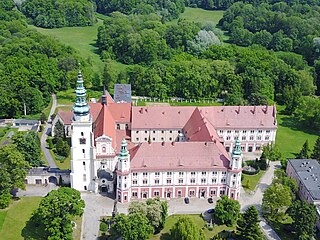
The Cistercian Monastery Complex in Henryków is a post-Cistercian Baroque monastery complex containing the Church of the Assumption of the Blessed Virgin Mary and St. John the Baptist located in Henryków, Poland.

Neukloster Abbey was a Cistercian abbey in Wiener Neustadt, in Lower Austria. In 1881, it became a priory of Heiligenkreuz Abbey.

Osek Monastery is a Cistercian monastery in Osek in Ústí nad Labem Region of the Czech Republic. Originally built in the 13th century as a Romanesque-Gothic structure, it was transformed into the high-Baroque style during the early 18th century, giving it the today's appearance. The monastery complex comprises the Church of Assumption of Virgin Mary, the building of the convent, the abbot's residence (prelature) with a clock tower, and several auxiliary buildings.




















